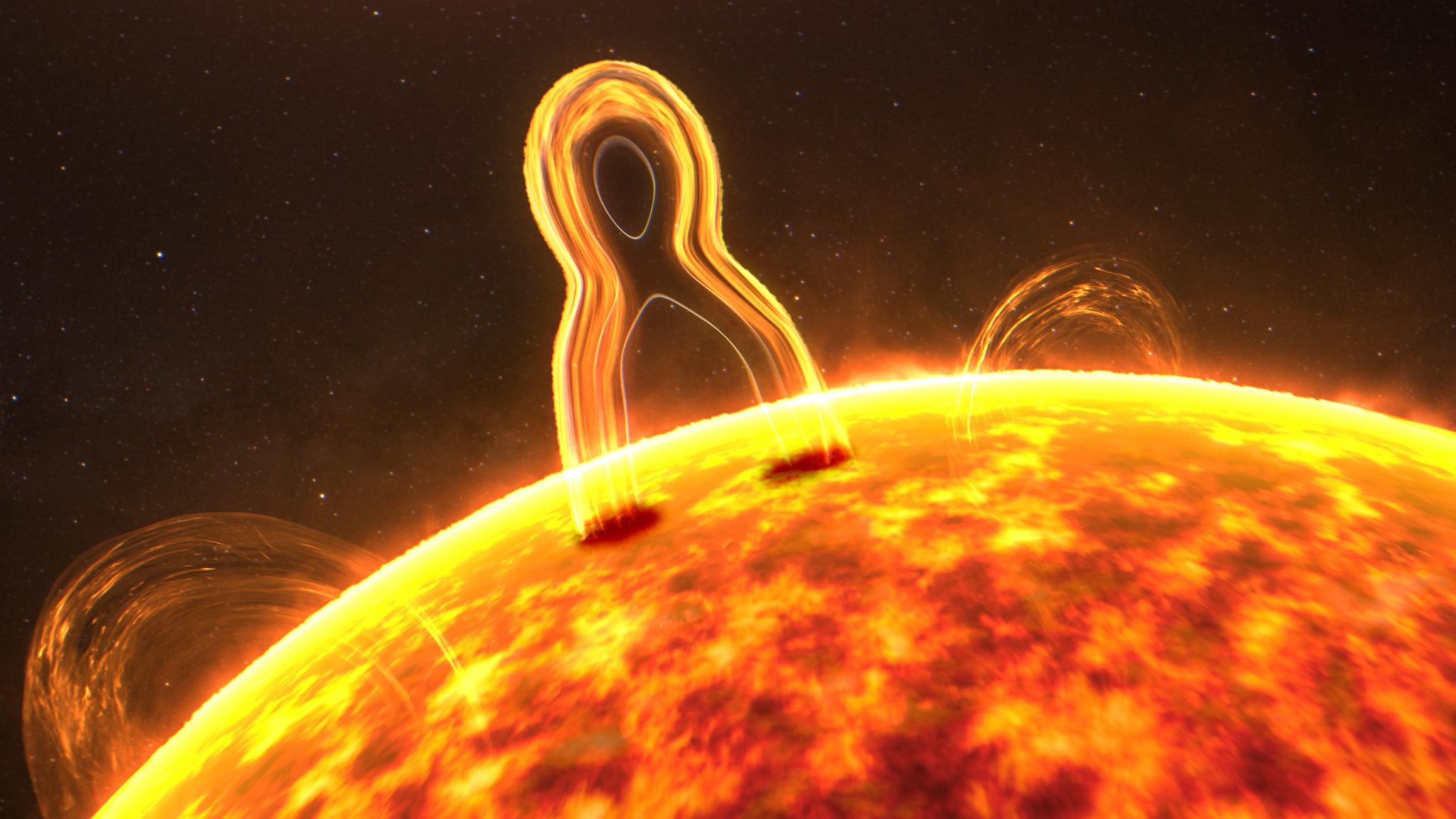
Solflammer og utstøting av koronale masse på solen er forårsaket av “magnetisk gjenkobling” – når magnetiske feltlinjer i motsatte retninger smelter sammen, går sammen igjen og knepper fra hverandre, og skaper eksplosjoner som frigjør enorme mengder energi. Kreditt: NASA Conceptual Image Laboratory
Forskere identifiserer fysikken som muliggjør raske magnetiske eksplosjoner i verdensrommet.
Når magnetfeltlinjer i motsatte retninger smelter sammen, skaper de eksplosjoner som kan frigjøre enorme mengder energi. Sammenslåingen av motstående feltlinjer på solen skaper solflammer og koronale masseutkast, som er massive eksplosjoner av energi som kan reise til jorden på mindre enn en dag.
Mens den generelle mekanikken til magnetisk gjenkobling er godt forstått, har forskere kjempet i over et halvt århundre for å forklare den nøyaktige fysikken bak den raske energifrigjøringen som skjer.
En ny Dartmouth-forskningsstudie publisert i går (28. april 2022) i tidsskriftet Kommunikasjonsfysikk gir den første teoretiske beskrivelsen av hvordan et fenomen kjent som “Hall-effekten” bestemmer effektiviteten til magnetisk gjenoppkobling.

Magnetisk gjentilkobling skjer når magnetiske feltlinjer i motsatte retninger smelter sammen, går sammen igjen og knepper fra hverandre, og frigjør enorme mengder energi for å varme opp plasmaer og drive høyhastighets utstrømninger. Kreditt: Yi-Hsin Liu/Dartmouth College
“Hastigheten med hvilken magnetfeltlinjer kobles sammen igjen er ekstremt viktig for prosesser i rommet som kan påvirke jorden,” sa Yi-Hsin Liu, assisterende professor i fysikk og astronomi ved Dartmouth. “Etter tiår med innsats har vi nå en fullstendig teori for å løse dette langvarige problemet.”
Magnetisk gjenkobling eksisterer i hele naturen i plasmaer, den fjerde tilstanden av materie som fyller det meste av det synlige universet. Gjenkobling finner sted når magnetiske feltlinjer i motsatte retninger trekkes til hverandre, brytes fra hverandre, går sammen igjen og deretter knipser voldsomt bort.
Ved magnetisk gjentilkobling tvinger knipsingen av magnetiske linjer ut magnetisert[{” attribute=””>plasma at high velocities. The energy is created and displaced to plasmas through a tension force like that which ejects objects from slingshots.

Around the region where reconnection occurs, the departure of the ion motion (blue streamlines in (a)) from the electron motion (red streamlines in (a)) gives rise to the “Hall effect,” which results in the electromagnetic energy transport pattern illustrated by yellow streamlines in (b). This transport pattern limits the energy conversion at the center, enabling fast reconnection. Credit: Yi-Hsin Liu/Dartmouth College
The Dartmouth research focused on the reconnection rate problem, the key component of magnetic reconnection that describes the speed of the action in which magnetic lines converge and pull apart.
Previous research found that the Hall Effect— the interaction between electric currents and the magnetic fields that surround them—creates the conditions for fast magnetic reconnection. But until now researchers were unable to explain the details of how exactly the Hall effect enhances the reconnection rate.
The Dartmouth theoretical study demonstrates that the Hall effect suppresses the conversion of energy from the magnetic field to plasma particles. This limits the amount of pressure at the point where they merge, forcing the magnetic field lines to curve and pinch, resulting in open outflow geometry needed to speed up the reconnection process.

Dartmouth’s Xiaocan Li, postdoctoral researcher (left); Yi-Hsin Liu, Assistant Professor of Physics and Astronomy (center); Shan-Chang Lin, PhD candidate (right). Credit: Robert Gill/Dartmouth College
“This theory addresses the important puzzle of why and how the Hall effect makes reconnection so fast,” said Liu, who serves as deputy lead of the theory and modeling team for
The new theory could further the technical understanding of solar flares and coronal mass ejection events that cause space weather and electrical disturbances on Earth. In addition to using the reconnection rate to estimate the time scales of solar flares, it can also be used to determine the intensity of geomagnetic substorms, and the interaction between the solar wind and Earth’s magnetosphere.

Yi-Hsin Liu, Assistant Professor of Physics and Astronomy, Dartmouth College. Credit: Robert Gill/Dartmouth College
The research team, funded by the National Science Foundation (NSF) and NASA, is working alongside NASA’s Magnetospheric Multiscale Mission to analyze magnetic reconnection in nature. Data from four satellites flying in tight formation around Earth’s magnetosphere as part of the NASA mission will be used to validate the Dartmouth theoretical finding.
“This work demonstrates that fundamental theory insights reinforced by modeling capabilities can advance scientific discovery,” said Vyacheslav Lukin, a program director for plasma physics at NSF. “The technological and societal implications of these results are intriguing as they can help predict impacts of space weather on the electrical grid, develop new energy sources, and explore novel space propulsion technologies.”
The new study can also inform reconnection studies in magnetically confined fusion devices and astrophysical plasmas near neutron stars and black holes. Although there is no current applied use, some researchers have considered the possibility of using magnetic reconnection in spacecraft thrusters.
Reference: “First-principles theory of the rate of magnetic reconnection in magnetospheric and solar plasmas” by Yi-Hsin Liu, Paul Cassak, Xiaocan Li, Michael Hesse, Shan-Chang Lin and Kevin Genestreti, 28 April 2022, Communications Physics.
DOI: 10.1038/s42005-022-00854-x
This work is funded by the NSF’s PHY and AGS Divisions, NASA’s Magnetospheric Multiscale (MMS) mission, and the U.S. Department of Energy.
Co-authors of the study are Paul Cassak, West Virginia University; Xiaocan Li, Dartmouth; Michael Hesse, NASA’s Ames Research Center; Shan-Chang Lin, Dartmouth; and Kevin Genestreti, Southwest Research Institute.